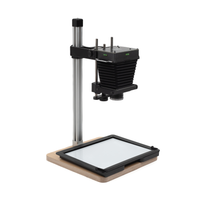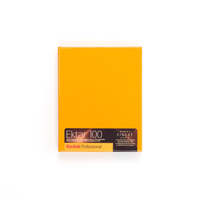Buying A Lens For Your 8x10 Camera

Stepping into the world of 8x10 large format photography is both exciting and intimidating! The sheer size and potential for incredible detail in your photographs is unparalleled, but the equipment can be daunting.
One of the most important pieces of the puzzle is choosing the right lens. This guide will walk you through the process and help you make an informed decision about your first 8x10 large format lens.
Understanding 8x10 Photography
Before delving into lenses, it's essential to grasp what sets 8x10 photography apart. Unlike smaller formats, 8x10 cameras offer unparalleled image quality, detail, and control over perspective and depth of field through camera movements such as tilt, shift, and swing. These capabilities demand lenses that are not only of high optical quality but also capable of covering the huge film area without vignetting, especially when employing significant movements.
Ok then lets get to the point. A 8x10 lens will have been designed specifically for use with large format cameras and will come mounted in a shutter and more often than not attached to a lens board. It will look something like this
The lens assembly consists of three main parts
- Lens: The lens is simply the glass in a metal barrel, usually in two parts that screw into the front and back of the shutter. It's unusual to find one that's not already mounted in a shutter, and we wouldn't recommend buying one without a shutter as your first lens.
- Shutter: The shutter controls the aperture and shutter speed of your lens, it is mechanical and works with very familiar settings that you will recognise from any of your cameras. Nothing to be intimidated by! Shutters are usually made by Copal, Seiko, Prontor or Compur and come in 3 basic sizes: '0' for smaller, lighter lenses, '1' for slightly larger lenses and '3' for the big lenses. For 8x10 most lenses will either be in a "1" or "3" size shutter. Shutters are often referred to as Copal 0, Copal 1 and Copal 3, as Copal dominated the market for so long that its name became synonymous with large format shutters.
- Lens Board: The lens board is what the lens and shutter are attached to by a threaded ring, different camera manufacturers use different sizes of lens boards, but the most popular style for 8x10 is the 'Sinar' lens board, Intrepid 8x10 cameras accept this board as well as our own. Sinar is an old manufacturer of large format cameras so the brand name has stuck to this size of board, despite them being made by many different manufacturers over the years. look for the shape of the board not the brand. Normally when you buy a 8x10 lens it will come on one of these lens boards, but if you are not sure what size board to get you can simply buy one from our website.

Sinar Style Lens Board
Most common lens board for 8x10

Lens Mounted on Lens Board
There is a threaded ring that will come with your lens that secures it to the board.
Now that you understand what makes up a large format lens (glass, shutter and lens board) it is time to think about how to buy one. You will be buying a second hand lens as they are no longer being manufactured new, however there is an abundance of these lenses in stock and for the quality of the glass we think they are one of the best deals in photography!
Most people find it easiest to get a lens from eBay so we will talk about that here, but there are other places worth checking such as KEH, Cat Labs, West Yorkshire Cameras and your local 2nd hand camera shop.
Knowing what to type in to search for a lens on eBay can be half the battle, I would recommend searching in terms of shutter size so for 8x10 try searching for "Copal 1 Lens" or "Copal 3 Lens" these search terms will bring up a huge range of lenses so lets dial into what lens specs will be best for you.
What to Consider When Buying a 8x10 Lens
1. Focal Length
- Wide-Angle (150mm - 240mm): Ideal for landscape and architectural photography, wide-angle lenses offer a broad view. Remember, due to the larger format, a 150mm lens behaves more like a 24mm lens on a normal camera.
- Normal (240mm - 360mm): Offering a field of view similar to the human eye, these lenses are versatile for various subjects, from portraits to still life. If you are used to lenses on 35mm cameras or full frame DSLRs a good trick is to multiply the focal length by 6. for example a 50mm lens on a 35mm camera is the equivalent to a 300mm lens on 8x10
- Long Lens (400mm and above): Best suited for portraits or compressing distant scenes, long lenses on 8x10 cameras do require careful handling to mitigate camera shake and maintain sharpness but can produce some of the most beautiful results.
2. Lens Coverage
A lens must have enough image circle coverage to not only cover the entire 8x10 film area but also allow for movements without vignetting. This is crucial for exploiting the full potential of large format cameras, particularly for architectural and landscape photography where movements are frequently used. The absolute minimum image circle is 325mm and ideally you want something a little larger.
3. Maximum Aperture
Large format lenses typically have smaller maximum apertures (e.g., f/5.6, f/8) compared to smaller format lenses. While this might seem limiting, the depth of field is much narrower in large format photography, creating beautiful bokeh when used wide open. A larger maximum aperture can be beneficial for low light conditions and for focusing on the ground glass. The depth of field on a 300mm 8x10 lens wide open at f5.6 is razor thin.
Our Top 4 Starter Lenses for 8x10
1. Rodenstock APO Ronar 300mm f9
2. Schneider Apo Symmar 210mm f5.6
3. Fujinon A 240mm f9
4. Fujinon W 300mm f5.6
Vintage Lenses
One of the great things about the 8x10 format is the huge range of vintage lenses you can play with. Many of the lenses, often in brass barrels, can be found relatively cheaply online and will easily cover 8x10 film. The downside is that they don't come in shutters or standard sizes, so a bit of DIY is required, but they can be great if you want to play with paper negatives, wetplate or very slow speed film where you can get away with long exposure times.
Conclusion
For beginners, a lens in the normal range (240mm - 360mm) is often recommended as it offers the most versatility and ease of use. Brands like Schneider, Rodenstock, Nikkor, Kodak Ektar and Fujinon have excellent reputations and offer a huge range of lenses, any of which would be a great first lens
Selecting your first 8x10 lens is a blend of personal preference, artistic intention, and practical considerations. By understanding the factors outlined above, you can make an informed decision that not only meets your technical requirements but also inspires your creative endeavours. Remember, the right lens is a tool that should expand your photographic creativity! So make sure to check it is fully working and free from dust scratches and fungus.
Ready to Take a Look at Our 8x10 Cameras?

Intrepid 8x10 Camera
£620.00
Weighing just 2.8 kg this is the lightest, most compact 8x10 film camera ever made. Now in its 4th generation and by far our most refined and advanced.

Intrepid 8x10 Black Edition
£670.00
The long-awaited Intrepid 8x10 Black Edition MK4 retains the classic features of all Intrepid Cameras but has a sleek, modern look.

Intrepid 8x10 Lens Board
£30.00
Designed to perfectly fit all Intrepid 8x10 cameras. Available in a choice of 3 sizes to fit all standard Copal shutter types.

Intrepid Lens Board Adapter
£40.00
The lens board adapter enables you to also use lenses mounted on Intrepid 4x5 boards on the Intrepid 8x10 camera. Not having to fiddle around with changing over lens boards can be a massive time saver, especially when out in the field.
















